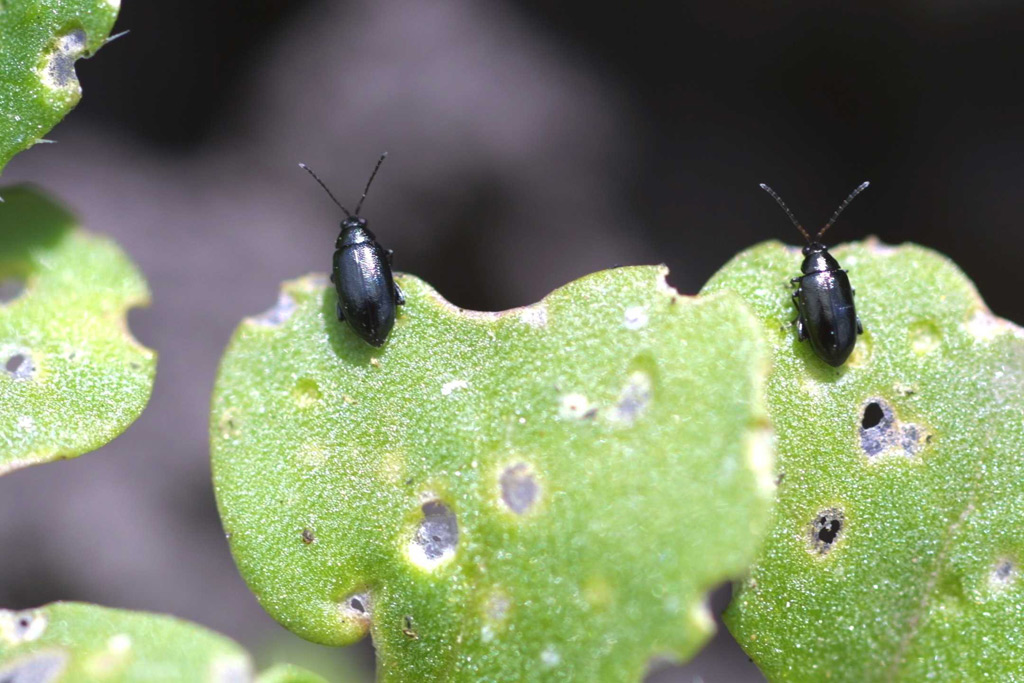
Cabbage stem flea beetle (CSFB) larvae assessments conducted at 12 commercial winter oilseed rape (WOSR) field sites during 2014–15 have revealed that the relationship between CSFB adults, larvae and yield is not straightforward.
The assessments, funded by AHDB Cereals & Oilseeds, took place at high-risk and low-risk sites – based on incidence of previous adult CSFB feeding damage – in six counties (Bedfordshire, Cambridgeshire, Hampshire, Hertfordshire, Suffolk and Surrey).
Plant samples were taken from each site in February 2015 and April 2015. Petioles and stems were dissected at ADAS laboratories to determine average larvae numbers.
Adult–larvae relationship
It was discovered that larval populations often related to the amount of CSFB adult feeding damage observed by agronomists during crop establishment. However, this was not always the case.
Miss Caroline Nicholls, AHDB Research Manager, said: “One of the factors influencing the number of larvae is the efficacy of pyrethroid sprays used to control adults.
“In this survey, the effectiveness of sprays across sites was mixed. It’s likely that pyrethroid resistance may have been the cause, although these CSFB populations were not tested for resistance in the lab.
“Even where adults were controlled to some degree, it may not necessarily have reduced subsequent larval pressure as eggs may have already been laid.”
Larvae numbers
It was discovered that the presence of leaf scarring (larvae entry and exit holes) provided a reliable, easy and non-destructive way to assess whether plants contained larvae.
Plant dissections were conducted to assess the number of larvae per plant. On both sampling occasions, the majority of larvae were located in the petioles, rather than the stem.
On average, more than five larvae per plant – the October/early November treatment threshold – were found in all counties, except the sites in Surrey.
The highest average population densities (27.8 larvae per plant) were observed at a site in Cambridgeshire.
Larvae number-yield relationships
No significant relationship between larval pressure and yield loss was found. However, a general trend for decreasing yield with increasing larval numbers was observed.
Miss Nicholls said: “We funded this work to better understand the relationship between CSFB beetle numbers and larvae numbers but took the opportunity to look at yield impacts too.
“There was a limited number of trial sites in this study and it was always going to be challenging to pinpoint yield effects.
“Due to the vast range of factors involved, it will require a much larger set of trials to separate out the yield effects caused by CSFB larvae.”
Larvae numbers in 2015–16 season
As part of the Defra-funded annual autumn pest assessment, 25 plants from each of 100 sites across England are destructively sampled at the Food and Environment Research Agency (Fera).
The latest dataset reveals an increase in the average number of CSFB larvae per plant over the last few years.
Prior to 2014–15, average number of larvae per plant was below 0.5 (2009–2014). Since then, numbers have increased by a relatively large amount.
Data from autumn 2015 show that the increase has been highest in the East with, on average, 3 larvae per plant.
Miss Nicholls concluded: “These averages mask the significant local variability in larvae numbers. Far higher counts were recorded at some of the sites in our 2014–15 study.
“We have funded ADAS to monitor larval populations again this year and interim results show that larval populations, as might be expected, are also higher than the Defra-reported average. For example, one high-risk site in Cambridge yielded an average of 45 larvae per plant.
“In contrast to 2014, larvae are being detected in far higher numbers in stems, rather than petioles. We don’t know yet why this is and it is another illustration of how little we know about this pest.
“The hot topic at the moment is how to nail down the numerous elements that alter CSFB risk across the season.
“This information is essential for the field-by-field management approaches necessary in a world where neonicotinoid insecticides continue to be restricted.”
